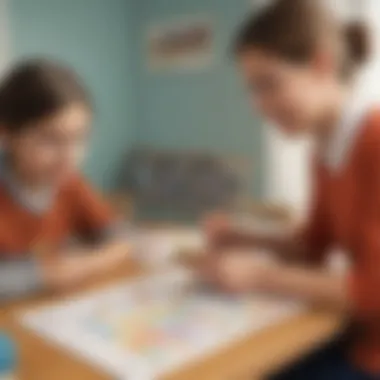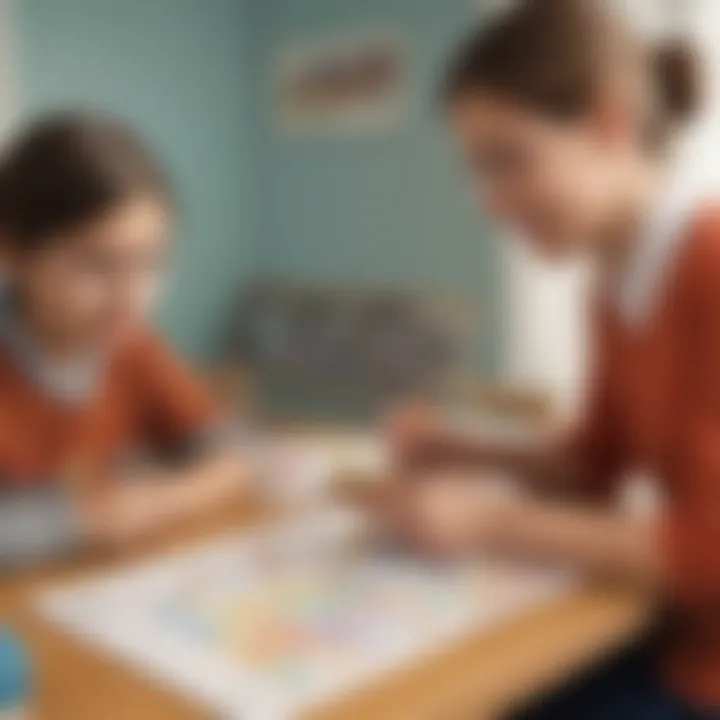Understanding the Significance of Numbers in Math


Intro
Numbers surround us every day, from the time on a clock to the price of a favorite snack. Understanding their value is essential, especially in this fast-paced world. Numbers do more than just count apples or tally how many days until summer vacation; they unlock the mysteries of the universe in a way that's surprisingly fun and engaging.
In this guide, we will unpack the fascinating world of numbers. We won't just skim the surface; we'll dive deep into how numbers interact with one another and what they mean in different scenarios. This knowledge is crucial not just for passing tests, but for solving real-world problems with confidence.
Whether it's basic math operations like addition and subtraction or understanding more complex concepts like fractions and percentages, we aim to make this journey enjoyable for elementary school students. So grab your pencils and paper as we embark on this adventure!
Creative Activities
Engaging young minds with numbers through creative activities can make all the difference. These hands-on experiences help children grasp mathematical concepts in a lively and enjoyable manner. Here are some ideas:
- Craft Ideas: Create your own number cards using bright colored paper! Children can use scissors to cut shapes and markers to write numbers in different fonts. This visual element reinforces number recognition and engages artistic skills.
- Step-by-Step Guides: Let's break down a fun project: making a giant number poster.
- Educational Value: These activities not only build creativity but also nurture fine motor skills and number recognition. Children become comfortable with numbers while expressing themselves artistically.
- Gather materials like poster board, markers, and stickers.
- Write down large numbers from 1 to 10 on the board.
- Next to each number, have the kids draw corresponding items (e.g., three apples for the number 3).
- Hang it up in your learning space for constant visual reinforcement.
Fun Quizzes
To solidify their understanding, quizzes can serve as an excellent resource for kids. With playful challenges, they can test their knowledge and build confidence in their math abilities. Here are a few aspects of these quizzes:
- Quiz Topics: Children can dive into different subjects, ranging from basic addition and subtraction to recognizing shapes and learning about measurement.
- Question Types: Quizzes can include multiple-choice questions, fill-in-the-blanks, and matching games. Engaging formats help keep their attention focused.
- Knowledge Reinforcement: These quizzes act like a quick checkup for what they've learned. If children see where they excel or where they might struggle, it encourages them to keep pushing forward in their number journey.
Fact-Based Articles
Exploring factual content broadens children's understanding while keeping them interested. The articles available provide a great deal of insight into the world of numbers.
- Topics: A myriad of subjects is covered, including the history of numbers, how they’re used in different cultures, and the significance of math in nature.
- Engaging Content: Articles are designed with vibrant visuals and simple language that make even complex topics accessible. Knowing what numbers represent in the world around them is essential for young learners.
- Additional Resources: For interested readers, further exploration can be found through links to related articles on Britannica or discussion forums like Reddit where math enthusiasts share their knowledge and tips.
Through fun activities, quizzes, and insightful articles, children can find joy in learning about numbers. They might discover that math is not just about numbers; it’s a language that helps them interpret the world.
As we untangle the mystery of numbers together, our goal is to foster a genuine appreciation for their value, one playful experience at a time.
Prelude to Numerical Values
Understanding numerical values is fundamental to grasping the larger world of mathematics. This section shines a spotlight on the building blocks of numerical relationships and highlights their relevance in everyday life. Emphasizing the basics in this article sets the stage for more complex concepts later on, offering young learners a solid foundation on which to build their mathematical understanding. The journey through numerical values fosters critical thinking and enhances problem-solving skills, as students begin to recognize how numbers shape the world around them.
What is a Number?
At its core, a number is more than just a symbol; it represents a specific quantity or position. Think of numbers as the language of quantity. For instance, when you see the number "5," it can mean five apples, five cars, or even a position in line. Numbers allow us to communicate amounts clearly. They can be small, like 1, or large, such as 1000.
Numbers can be categorized into various types:
- Whole Numbers: These are just the counting numbers starting from zero and going up (0, 1, 2, ).
- Integers: This group expands whole numbers to include negative values (-1, -2, -3, ).
- Fractions: Represent parts of a whole, like 1/2 or 3/4.
- Decimals: Extend the number line further to include values such as 0.5 or 3.14.
Recognizing what a number is can help children understand its significance in further mathematical exploration. Numbers lay the groundwork for exploring operations, patterns, and much more.
The Concept of Value in Mathematics
The value in mathematics reflects the worth of a number based on its position and context. Take a look at the number 215. Here, the digits do not just stand alone; their value is determined by their position:
- The '2' stands for 200 (two hundreds).
- The '1' represents 10 (one ten).
- The '5' signifies 5 (five units).
This principle is known as place value, and it forms the backbone of how we understand larger numbers. When kids grasp it, they not only understand what numbers mean but also how to manipulate them in arithmetic operations.
The concept of value goes beyond mere numbers. It connects to real-life scenarios, like money or measurements, reinforcing the importance of numbers in various aspects of life. For example, the value of a one-dollar bill is intuitive to most children, as they can directly relate it to toys or treats they want.
A well-rounded understanding of numbers and their values serves as an essential tool for young learners. It prepares them for more intricate mathematical concepts they will encounter in their educational journey.
Understanding Whole Numbers
Understanding whole numbers is a fundamental concept in mathematics. This aspect not only lays the groundwork for more complex arithmetic but also contributes significantly to various real-world applications. Whole numbers encompass the numbers we use on a daily basis— zero, one, two, three, and so on. They represent complete quantities without fractions or decimals, making them essential in everything from counting objects to managing finances.
Furthermore, grasping whole numbers helps with decision-making skills in everyday life—for instance, determining how many slices of pizza to order for a party, or how many apples are needed for a recipe. By mastering the concept of whole numbers, learners gain confidence in their ability to handle numbers, facilitating a deeper understanding of mathematics as a whole.
"Whole numbers form the bedrock of our numerical system and provide the clarity needed for effective calculations."
Defining Whole Numbers
Whole numbers are a sequence that starts from zero and includes all positive integers. This means they are represented as:
0, 1, 2, 3, 4, 5,
Well, it’s quite simple. Whole numbers are essentially the countable numbers you can grasp in the real world. You can visualize them as objects— for instance, if you see four apples, the number '4' directly represents the number of apples. Understanding whole numbers allows individuals to quantify and categorize things around them.
The Importance of Zero
Zero is more than just a placeholder; it plays a pivotal role in the number system. While many may overlook its significance, zero is crucial for several reasons. First, it represents the concept of nothingness. For example, if you have three cookies and eat all three, you are left with zero cookies. Second, zero is essential in defining the boundaries in mathematics. It serves as the starting point on the number line, separating positive and negative numbers.


In financial terms, consider an account balance of zero. It indicates you neither owe money nor have money available, thereby affecting your financial decisions. Educators often emphasize the concept of zero early on to help students understand its relevance from both quantitative and operational perspectives.
Counting and Ordering Numbers
Counting is one of the first mathematical skills developed by young learners. Whole numbers are the backbone of counting— when you begin counting items like toys or books, you use whole numbers. The process is straightforward: you start at one and continue sequentially.
Ordering numbers is another vital skill that emerges from this foundation. Whole numbers can be arranged in a sequence based on their value, allowing for effective comparisons and organizational skills.
- To facilitate counting and ordering, consider using visual representations, such as:
- Number lines: Helps visualize the position of whole numbers.
- Set of objects: Grouping several blocks or toys can provide a tangible way to grasp the concept of order among numbers.
Engaging students with various exercises related to counting and ordering enhances their understanding and comfort with whole numbers, ultimately preparing them for advanced mathematical concepts.
Understanding Decimal Numbers
Understanding decimal numbers is a foundational aspect of mathematics that opens up a world of possibilities for young learners. These numbers allow for precise representation of values that whole numbers can't capture. Imagine, for instance, a pizza that has been cut into eight slices. If someone eats three slices, it’s straightforward to state how many pieces are left—five. However, if you want to split those remaining slices between two people and express the portions they get, decimals become essential. Each half of a slice from that pizza cannot simply be viewed as a whole number; it's represented far better using decimal numbers.
In this section, we will explore the significance of decimal places and the ability to compare decimal values, highlighting how these skills benefit students' overall understanding of numeracy.
Exploring Decimal Places
Decimal places denote the position of digits to the right of a decimal point. This aspect of numbers is crucial because it indicates precision. Each place after the decimal divides our value into ten equal parts, allowing for an intricate representation of amounts. For example, taking the number 3.14, you get:
- The digit before the decimal (3) represents the whole number.
- The digit immediately after the decimal (1) signifies tenths, and the next digit (4) signifies hundredths.
This depth in representation helps students grasp the concept of fractions in a more approachable way. For instance, if a child measures 2.75 meters in height, they can understand that this means 2 whole meters and 75 hundredths of a meter. It reinforces the idea that even small parts of a whole can be significant, building a strong foundation for more complex mathematical concepts later on.
Transitioning to decimal understanding involves hands-on activities, such as using rulers or measuring cups in cooking. Seeing how decimals work in real life can transform comprehension from abstract numbers into tangible values. The more familiar students become with decimal places, the easier it will be for them to navigate the world of mathematics.
Comparing Decimal Values
Once students have a grip on decimal places, the next step is comparing those decimal values. Understanding which decimal is larger or smaller is vital in everyday scenarios—like comparing prices at the store or measuring distances. Let's say two friends shop for the same toy:
- Toy A costs $12.99.
- Toy B costs $12.49.
In this instance, a student can learn to understand that Toy A is more expensive because 99 hundredths is greater than 49 hundredths. This eye for comparison hones critical thinking skills, engaging students in logical reasoning and analytical thinking.
Here, practice is key. Students can use comparison symbols, such as , >, and =, to help grasp the concept. Activities like:
- Comparing the Decimals: Give them a list of decimal numbers and ask them to arrange them in order from smallest to largest.
- Real-life Scenarios: Let them simulate shopping, making choices based on price differences.
"Understanding decimals is more than just about numbers; it’s about making informed decisions in daily life. Knowing how to compare values lets us make choices that are better suited for our needs."
Ultimately, comprehension of decimal numbers enriches the toolbox for students as they face the realm of mathematics and daily decision-making, ensuring they are equipped for more advanced topics down the road.
Performing Basic Arithmetic Operations
Performing basic arithmetic operations is like the cornerstone of our mathematical knowledge, laying the foundation for more advanced numerical concepts. In this part, we’ll discover how addition, subtraction, multiplication, and division help us understand and find value in numbers. Each operation has its own unique role, allowing us to manipulate numbers and interpret their meanings in various contexts.
Addition and its Role in Finding Value
Addition is often the first arithmetic operation that children learn, and for good reason. When we add two or more numbers, we’re essentially combining them to find a total value. Think of a child collecting apples. If they have 2 apples, and then they receive 3 more, they now possess a total of 5 apples. In this case, addition helps us find the new value of apples.
Moreover, addition is crucial in everyday life. Imagine at the grocery store; if you want to buy 2 packets of cookies for $3 each and a juice for $2, you add those costs together to figure out total expenses. This straightforward operation reveals the importance of numbers in real-world scenarios, encouraging kids to recognize how adding can lead to insightful values.
Subtraction as a Means of Determining Change
Subtraction is another fundamental operation that often tells a story of change. It helps in understanding how much is left when something is taken away. For instance, if a child has 10 candies and shares 4 with friends, they can subtract to find out how many candies remain. 10 minus 4 equals 6.
In a broader context, subtraction aids in problem-solving. It allows us to see differences and disparities. When figuring out how much money is left after buying something, one subtracts the cost from the available amount. Subtraction thus not only uncovers what remains but also shows the contrasts in values.
The Nature of Multiplication
Multiplication can be viewed as repeated addition; however, it introduces a new level of complexity and efficiency in finding totals. Picture a situation where you have 4 boxes, and each contains 5 books. Instead of adding 5 repeatedly (5 + 5 + 5 + 5), multiplication allows you to compute this as 4 times 5, equating to a total of 20 books.
Multiplication elegantly captures large quantities without excessive counting. It’s beneficial in areas like area calculation, where length is multiplied by width. Students learning multiplication will find patterns emerging, like the multiplication table, which further enriches their understanding of numbers and how values scale.
Understanding Division's Role in Value Identification
Division may seem complex at first, but it's simply about distributing or splitting a total into equal parts. If a child has 12 cookies and wants to share them with 3 friends, division can help them find out how many cookies each person receives. This situation illustrates that 12 divided by 3 equals 4.
More than just fair sharing, division fosters understanding of ratios and proportions. If you’re familiar with pizza, for instance, dividing a pizza into equal slices helps ensure everyone enjoys the same amount. It’s this process of breaking down values that empowers individuals to grasp concepts of equality and fairness.


"Understanding these basic operations opens the door to a world of numerical exploration. Every equation tells a story of value, change, arrangement, and balance."
Exploring Fractions
Understanding fractions is a crucial part of grasping the value of numbers. They are not just pieces of a whole; they illuminate how we can break things down and understand parts in a more significant context. Imagine sharing a pizza among friends—each slice represents a fraction of the entire pie. This concept helps kids learn how to express a part of something rather than always focusing on the whole picture.
Fractions challenge students to think critically about numbers and their relationships. They find relationships between values, which is a skill applicable beyond mere math exercises. The appeal of fractions lies in their ability to represent various real-world scenarios, such as measurements in cooking or carpentry, where precise divisions are necessary.
What are Fractions?
Fractions represent a way to understand division in a visual format, showing how a whole can be divided into smaller parts. Each fraction is made up of two numbers: the numerator, which is the number above the line, and the denominator, which is the number below it. For instance, in the fraction 3/4, three is the numerator, indicating how many parts you have, while four is the denominator, showing how many equal parts the whole is divided into.
This visual representation is essential for young learners. It enables them to see that fractions are everywhere in our daily experiences, from measuring ingredients to dividing items among people. By recognizing this, they can better appreciate the role of fractions in life's practicalities.
Finding Equivalent Fractions
Finding equivalent fractions is like finding different ways to describe the same thing. For example, the fractions 1/2, 2/4, and 3/6 all represent the same value despite being written differently.
To find equivalent fractions, you can multiply or divide the numerator and denominator by the same number. For instance:
- Multiply: 1/2 × 2/2 = 2/4
- Divide: 4/8 ÷ 4/4 = 1/2
This skill helps students understand that numbers can take many forms while still holding the same value. Recognizing equivalent fractions prepares them for more complicated mathematical concepts down the road and strengthens their confidence. It also encourages flexibility in their thinking, which is a substantial benefit in all areas of learning.
Adding and Subtracting Fractions
Adding and subtracting fractions often causes students to sweat bullets because it can seem complicated at first. In truth, once you understand the process, it can become quite straightforward.
When fractions share the same denominator—the bottom number—adding or subtracting fractions involves simply adjusting the numerator—the top number. For example, to add 1/4 + 2/4, you just combine the numerators, resulting in 3/4, while keeping the denominator the same.
But what happens when the denominators aren’t the same? That’s when students need to find a common denominator. This process may include:
- Determining the least common multiple of the denominators, such as for 1/3 and 1/4, the least common multiple is 12.
- Changing the fractions to equivalent fractions using the common denominator: 1/3 becomes 4/12, and 1/4 becomes 3/12.
- Finally, add or subtract: 4/12 + 3/12 = 7/12.
Adding and subtracting fractions not only shows how parts relate but also enhances problem-solving skills and helps with understanding larger math concepts.
Real-World Application of Numbers
Numbers are everywhere in our lives, from the moment we wake up to the time we go to sleep. They influence our decisions, measure our surroundings, and shape our understanding of the world. So, why focus on the real-world applications of numbers? Well, grasping how numbers operate in day-to-day situations helps children see their significance beyond the classroom. This insight not only makes math more relatable but also empowers them with practical skills.
Numbers in Daily Life
Everyday activities are filled with numerical values. Take grocery shopping as an example. When parents take their kids to the store, they use numbers to budget and ensure they stay within a spending limit. Kids can help by checking prices, calculating totals, or even figuring out how many items they can purchase without busting the bank. In fact, this simple task teaches them valuable lessons about addition, subtraction, and the importance of making wise financial decisions.
In addition to shopping, numbers also play a crucial role in time management. When scheduling activities from school to sports, children learn the importance of punctuality. For instance, knowing when to leave the house to arrive on time for a soccer practice requires an understanding of clocks and timelines. Thus, numbers develop skills that prepare them for future responsibilities.
"Numbers are the universal language of science and finance." This quote emphasizes how these figures serve as tools of communication that everyone understands, from mathematicians to everyday folks trying to balance a checkbook.
Measurement and Value
Understanding measurement is critical; after all, it ties directly into real-world scenarios where numerical values matter. From measurement in cooking recipes to calculations in construction projects, figures help quantify and compare.
In cooking, for instance, precise measurements determine outcomes of dishes. A child might learn that one cup of sugar is sweeter than half a cup. They gain insight into fractions when doubling a recipe for a birthday cake or halving ingredients for a smaller gathering. This practical experience fosters not only math skills but also creativity and problem-solving abilities.
In a more hands-on example, consider when a child assists a parent in gardening. Using a tape measure to space plants or assessing the height of growing veggies encourages an appreciation of both measurement and growth in nature. Kids get to practice dividing spaces evenly for even growth, which relays foundational concepts of area and division in math.
Emphasizing these daily examples puts numbers into perspective. They are not abstract concepts but instead serve real purposes that connect various fields of knowledge. By teaching these principles, we help our children develop skills that they will use throughout their lives, all while making math an exciting and applicable subject.
Understanding the Number Line
The number line is a fundamental tool in mathematics, serving as a visual representation of numbers and their relationships. Through this simple yet profound concept, learners can grasp various numerical values and how they interconnect. It not only provides a foundational understanding of arithmetic operations but also assists in visualizing mathematical concepts that can sometimes be abstract and challenging. Thus, understanding the number line enables students to anchor their learning of more complex ideas later on.
What is a Number Line?
A number line is essentially a straight line with numbers placed at equal intervals along its length. It stretches infinitely in both directions, displaying negative numbers on one end and positive numbers on the other. Starting from a central point, typically zero, it allows individuals to see how far apart numbers are from each other.
On the number line, each point corresponds to a number, and the distance between any two points reflects the difference in their values. Students can easily visualize how numbers relate to one another, whether they are adjacent or far apart. Understanding that numbers can be placed on this line helps solidify the idea of ordering and comparing values.
"The number line is like a roadmap for numbers—guiding us through their relationships and values."
Using the Number Line to Identify Values
When it comes to identifying values, the number line is an essential reference. It can help children understand concepts such as addition, subtraction, and even more complex operations such as finding averages or distances. Here are some key benefits:


- Visual Aid: Seeing numbers placed on a line helps children visualize their size and relationships, leading to better comprehension.
- Comparison: Using the number line, students can easily compare numbers. If one number is to the right of another, it's larger; if it’s to the left, it’s smaller.
- Arithmetic Operations: Addition can be demonstrated by moving to the right on the number line, while subtraction involves moving to the left. This movement clearly illustrates how values increase or decrease.
For young learners, engaging in activities where they plot numbers on a number line or solve problems can greatly enhance their understanding. This interactive approach often makes the learning process an enjoyable experience, fostering their interest in mathematics. Activities might include:
- Marking Numbers: Give children a set of numbers and ask them to mark them on a blank number line. This hands-on task reinforces their understanding of order.
- Number Line Games: Simple games that require moving around a number line based on addition or subtraction problems can make learning fun.
In summary, mastering the use of the number line is a stepping stone toward more advanced mathematical concepts. It helps students build a concrete understanding of values, enabling them to navigate the often abstract realm of numbers with greater ease.
Exploring Patterns and Sequences
In the world of numbers, patterns and sequences serve as fundamental building blocks. Understanding them not only contributes to mathematical proficiency but also enriches critical thinking and problem-solving skills. To grasp concepts such as addition, subtraction, or even more advanced topics like algebra, recognizing these sequences can offer clarity. Patterns appear everywhere, whether in nature, art, or even in everyday activities like cooking. The significance of these patterns extends beyond academics; they help cultivate a deeper appreciation of the structured beauty surrounding us.
Recognizing Patterns in Numbers
Pattern recognition acts as a gateway to developing mathematical intuition. Students learn to identify repetition or symmetry in groups of numbers, which develops confidence in their numerical abilities.
For example, take the simple pattern: 2, 4, 6, 8 Here, each number increases by 2. Recognizing this allows a child to predict the next numbers without counting. This skill of prediction is not limited to numbers—understanding patterns helps in various real-life situations too.
- Strengthens Problem-Solving Skills: When children recognize patterns, they often find innovative ways to solve problems. This skill is crucial not only in math but also in life.
- Establishes a Foundation for Algebra: Patterns serve as the groundwork for understanding algebraic concepts. They help in grasping how variables relate to each other.
- Enhances Memory: When kids learn patterns, they tend to develop better memory skills, making it easier to recall information later.
Working with Number Sequences
Number sequences can seem abstract at first, yet they offer a treasure trove of understanding about how numbers interact with each other. A sequence is simply a list of numbers arranged in a specific order, often governed by a rule. Consider the sequence: 5, 10, 15, 20 This particular sequence increases by adding 5 each time.
Here are a few notable things about sequences:
- Identifying Different Types: Sequences can be arithmetic (where numbers increase by a constant), geometric (where they multiply by a constant), or Fibonacci (where each number is the sum of the two preceding ones). Learning to identify these types fosters a richer understanding of mathematics.
- Real-Life Applications: Sequences show up in schedules, budgeting, and even in the construction of buildings. Recognizing how to work with these sequences helps in decision-making and planning.
- Encourages Critical Thinking: Solving for missing elements in a sequence invites learners to think critically, testing their understanding and challenging their analytical skills.
"Recognizing patterns and understanding sequences are not just academic exercises; they are critical life skills that foster observation and thoughtfulness in our daily decision-making."
As students delve deeper into patterns and sequences, they develop a sense of rhythm in numbers, fostering a natural affinity for mathematical exploration. This understanding equips them with tools necessary not only for mathematics but for comprehending the world around them.
Games and Activities for Learning Values
Learning numbers and their values can be quite a journey for young minds. It’s common to see kiddos getting lost in a sea of figures, often feeling overwhelmed by basic concepts. This is where games and activities come into play. They provide a stimulating platform for understanding numeric values, making the abstract world of mathematics more tangible and engaging. By using interactive methods, children can grasp concepts in a lively manner, which tends to stick in their memory far better than rote learning.
One primary benefit of incorporating games is that they foster a playful learning environment where children feel comfortable making mistakes and trying again. The pressure of a classroom situation is often absent when playing games, allowing kids to explore numbers freely. This can be particularly effective for encouraging a love of math, as children often associate positive experiences with the activities they enjoy.
Moreover, these games can cater to various learning styles—visual, auditory, and kinesthetic—making them versatile in their approach. Whether it's using colorful cards, sound-based games, or physical movement, children can experience numbers in ways that resonate with them personally.
Interactive Number Games
Interactive number games form the backbone of a creative approach to learning about values. These games can take many forms—from simple card games to complex computer applications. One popular example is Bingo, where players must recognize and match numbers on their cards. This game not only sharpens number recognition skills but also enhances cognitive speed. By keeping track of open numbers, kids practice their ability to quickly assess value.
Here are ways to integrate number games:
- Card Games: Use a standard deck of cards and assign different values for each card. Turn over cards one at a time and add or subtract their values to reach a target sum.
- Board Games: Choose games like "Monopoly" where numerical understanding of currency and property values is key to winning.
- Online Games: Websites like CoolMathGames.com provide a plethora of games designed to reinforce value identification in an entertaining format.
It's essential to ensure that these interactive games are age-appropriate. A good game should challenge kids without making them feel defeated. Therefore, reviews and input from caregivers can guide their selection.
Math Puzzles for Discovering Values
While games tend to be high energy, math puzzles provide a calm and thoughtful way to navigate the depths of numerical values. Puzzles can range from simple addition riddles to intricate logic problems. They encourage children to think critically and apply their existing knowledge in new ways. Engaging with puzzles also lays the groundwork for more advanced problem-solving skills, vital in higher levels of math.
Consider introducing puzzles that require children to fill in blank spaces using a set of given numbers. Here's a simple example of a puzzle that can be introduced:
- If you have the numbers 1, 2, and 3, what different sums can you make?
This exercise promotes flexibility in thinking about numbers and their potential combinations. Puzzles can be enjoyed in pairs or small groups, encouraging teamwork and discussion among players.
In summary, incorporating games and puzzles into learning helps to demystify the value of numbers for elementary-aged children. By embracing a method that combines fun with education, children can not only understand but also appreciate the beauty and utility of mathematics in their everyday lives.
"Games and puzzles can take the pressure off learning, transforming a difficult task into a rewarding adventure."
Culmination
Bringing everything together, the conclusion of this exploration emphasizes the pivotal role numbers play in our daily lives. Understanding their value goes beyond just computations; it's about grasping their significance in various contexts—be it in a classroom setting, shopping, or even cooking. The journey through numbers helps us build a strong foundation in mathematics, which serves as a stepping stone for more advanced concepts.
Reflecting on Numeric Values
Reflecting on numeric values allows us to appreciate numeric diversity and the stories they tell. Each number serves a purpose, whether it’s indicating age, measuring distance, or representing data in graphs. By encouraging children to reflect on how and where they see numbers, we nurture their innate curiosity about the world around them. It's not just about understanding that three is less than five; it’s about recognizing that those numbers might represent apples in a basket or minutes in a race. This connection with the real world makes learning purposeful and enriching.
"Every number has a story to tell, and understanding it can make the difference between just knowing a fact and interacting with the world thoughtfully."
Encouraging a Love for Numbers
Fostering a love for numbers should start at a young age. When children can relate numbers to fun activities, like cooking or playing games, they develop a positive association. Simple activities like measuring ingredients for a favorite recipe or keeping score in a game can turn numerical concepts into engaging experiences. By celebrating small victories in understanding, like mastering multiplication or recognizing patterns, we cultivate enthusiasm. Sharing stories of famous mathematicians or interesting applications of numbers can also spark intrigue.
As adults, our role is to demonstrate that math isn’t merely about memorizing formulas but also about exploring and having fun. Encouraging children to embrace mistakes as learning steps is essential, as this mindset prepares them for challenges ahead. Let’s motivate the young minds to ask questions and seek answers, encouraging a lifelong appreciation of numbers as saviors in every situation.







